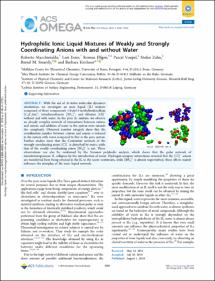Hydrophilic Ionic Liquid Mixtures of Weakly and Strongly Coordinating Anions with and without Water

Hydrophilic Ionic Liquid Mixtures of Weakly and Strongly Coordinating Anions with and without Water

| dc.contributor.author | Macchieraldo, Roberto | |
| dc.contributor.author | Esser, Lars | |
| dc.contributor.author | Elfgen, Roman | |
| dc.contributor.author | Voepel, Pascal | |
| dc.contributor.author | Zahn, Stefan | |
| dc.contributor.author | Smarsly, Bernd M. | |
| dc.contributor.author | Kirchner, Barbara | |
| dc.date.accessioned | 2020-11-13T11:40:46Z | |
| dc.date.available | 2020-11-13T11:40:46Z | |
| dc.date.issued | 08.2018 | |
| dc.identifier.uri | https://hdl.handle.net/20.500.11811/8774 | |
| dc.description.abstract | With the aid of ab initio molecular dynamics simulations, we investigate an ionic liquid (IL) mixture composed of three components 1-butyl-3-methylimidazolium [C4C1Im]+, tetrafluoroborate [BF4]−, and chloride [Cl]− without and with water. In the pure IL mixture, we observe an already complex network of interactions between cations and anions, and addition of water to the system even extends the complexity. Observed number integrals show that the coordination number between cations and anions is reduced in the system with water compared to that in the pure system. Further studies show that the Coulombic network of the strongly coordinating anion [Cl]− is disturbed by water, while that of the weakly coordinating anion [BF4]− is not. These observations can also be confirmed by the Voronoi polyhedra analysis, which shows that the polar network of microheterogeneous IL collapses by the introduction of water. Hydrogen-acceptor interactions revealed that the [Cl]− anions are transferred from being situated in the IL to the water continuum, while [BF4]− is almost unperturbed; these effects mainly influence the interplay of the ionic liquid network. | en |
| dc.format.extent | 16 | |
| dc.language.iso | eng | |
| dc.rights | In Copyright | |
| dc.rights.uri | http://rightsstatements.org/vocab/InC/1.0/ | |
| dc.subject | Salts | |
| dc.subject | Anions | |
| dc.subject | Mixtures | |
| dc.subject | Solvents | |
| dc.subject | Cations | |
| dc.subject.ddc | 540 Chemie | |
| dc.title | Hydrophilic Ionic Liquid Mixtures of Weakly and Strongly Coordinating Anions with and without Water | |
| dc.type | Wissenschaftlicher Artikel | |
| dc.publisher.name | ACS - American Chemical Society | |
| dc.publisher.location | Washington, DC | |
| dc.rights.accessRights | openAccess | |
| dcterms.bibliographicCitation.volume | 2018 | |
| dcterms.bibliographicCitation.issue | 3 | |
| dcterms.bibliographicCitation.pagestart | 8567 | |
| dcterms.bibliographicCitation.pageend | 8582 | |
| dc.relation.doi | https://doi.org/10.1021/acsomega.8b00995 | |
| dcterms.bibliographicCitation.journaltitle | ACS Omega | |
| ulbbn.pubtype | Zweitveröffentlichung |
Files in this item
This item appears in the following Collection(s)
-
Publikationen (6)




